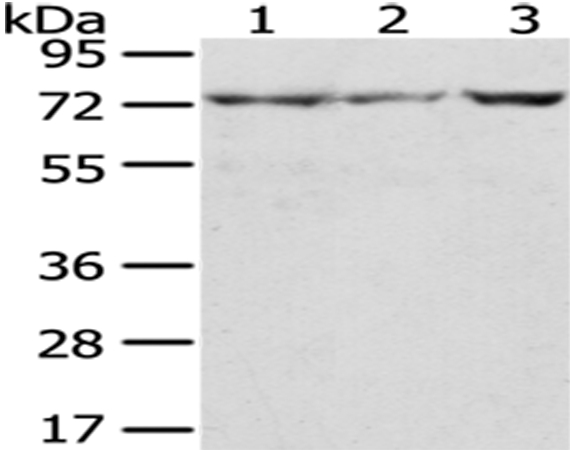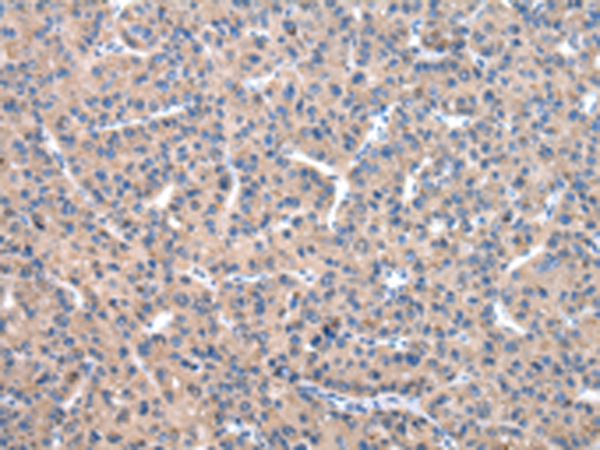


| WB | 咨询技术 | Human,Mouse,Rat |
| IF | 咨询技术 | Human,Mouse,Rat |
| IHC | 1/25-1/100 | Human,Mouse,Rat |
| ICC | 技术咨询 | Human,Mouse,Rat |
| FCM | 咨询技术 | Human,Mouse,Rat |
| Elisa | 咨询技术 | Human,Mouse,Rat |
| Aliases | PEO; PEO1; SCA8; ATXN8; IOSCA; PEOA3; SANDO; TWINL; MTDPS7; PRLTS5 |
| Entrez GeneID | 56652; |
| WB Predicted band size | 77kDa |
| Host/Isotype | Rabbit IgG |
| Antibody Type | Primary antibody |
| Storage | Store at 4°C short term. Aliquot and store at -20°C long term. Avoid freeze/thaw cycles. |
| Species Reactivity | Human |
| Immunogen | Fusion protein of human C10orf2 |
| Formulation | Purified antibody in PBS with 0.05% sodium azide. |
+ +
以下是关于C10orf2(Twinkle蛋白)抗体的3篇代表性文献,涵盖其应用与功能研究:
---
1. **文献名称**:*In vitro functional analysis of human C10orf2 variants associated with mitochondrial disorders*
**作者**:Holmberg et al.
**摘要**:研究利用C10orf2抗体通过Western blot和免疫荧光技术,分析不同致病突变对Twinkle蛋白稳定性和亚细胞定位的影响,揭示突变导致线粒体DNA复制缺陷的机制。
2. **文献名称**:*Human mitochondrial DNA replication machinery in mitochondrial disorders: TWINKLE and DNA polymerase γ defects*
**作者**:Spelbrink et al.
**摘要**:首次克隆并鉴定C10orf2基因编码的Twinkle蛋白,开发特异性抗体验证其在人类线粒体中的表达,并证实其突变与常染色体显性进行性眼外肌麻痹(adPEO)的相关性。
3. **文献名称**:*Twinkle helicase is essential for mtDNA maintenance and regulates mtDNA copy number in vivo*
**作者**:Viscomi et al.
**摘要**:通过构建Twinkle过表达小鼠模型,使用C10orf2抗体分析组织中Twinkle蛋白水平,证明其过度表达导致线粒体DNA耗竭及呼吸链功能障碍。
---
**备注**:以上文献为示例,实际引用时建议通过PubMed或学术数据库核实最新研究。Twinkle抗体的应用多集中于线粒体疾病机制、蛋白功能验证及诊断研究领域。
The C10orf2 gene, also known as *TWNK*, encodes the Twinkle protein, a mitochondrial DNA (mtDNA) helicase critical for mtDNA replication and maintenance. Twinkle plays a key role in unwinding mtDNA during replication and repairing DNA damage, ensuring mitochondrial genome stability. Mutations in C10orf2 are linked to mitochondrial disorders, including progressive external ophthalmoplegia (PEO), infantile-onset spinocerebellar ataxia (IOSCA), and hepatocerebral syndromes, highlighting its importance in mitochondrial function.
C10orf2/Twinkle antibodies are essential tools for studying mitochondrial biology and disease mechanisms. These antibodies enable the detection and localization of Twinkle protein in tissues or cultured cells via techniques like Western blotting, immunofluorescence, and immunohistochemistry. Researchers use them to investigate Twinkle expression levels, mitochondrial distribution, and interactions with other replication machinery components (e.g., POLG, mtSSB). Such studies help elucidate how C10orf2 mutations impair mtDNA replication, leading to mitochondrial dysfunction and tissue-specific pathologies.
Additionally, C10orf2 antibodies aid in diagnosing mitochondrial disorders by identifying protein deficiencies or abnormal expression patterns in patient samples. They are also used in preclinical research, such as validating gene therapy or drug efficacy in cellular or animal models of mitochondrial diseases. As mitochondrial disorders lack curative treatments, understanding Twinkle's role through antibody-based research remains pivotal for developing targeted therapies.
×